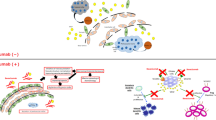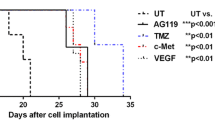Abstract
Targeting tumor angiogenesis is a potential therapeutic strategy for glioblastoma because of its high vascularization. Tivozanib is an oral pan-VEGF receptor tyrosine kinase inhibitor that hits a central pathway in glioblastoma angiogenesis. We conducted a phase II study to test the effectiveness of tivozanib in patients with recurrent glioblastoma. Ten adult patients were enrolled and treated with tivozanib 1.5 mg daily, 3 weeks on/1 week off in 28-day cycles. Brain MRI and blood biomarkers of angiogenesis were performed at baseline, within 24–72 h of treatment initiation, and monthly thereafter. Dynamic contrast enhanced MRI, dynamic susceptibility contrast MRI, and vessel architecture imaging were used to assess vascular effects. Resting state MRI was used to assess brain connectivity. Best RANO criteria responses were: 1 complete response, 1 partial response, 4 stable diseases, and 4 progressive disease (PD). Two patients were taken off study for toxicity and 8 patients were taken off study for PD. Median progression-free survival was 2.3 months and median overall survival was 8.1 months. Baseline abnormal tumor vascular permeability, blood flow, tissue oxygenation and plasma sVEGFR2 significantly decreased and plasma PlGF and VEGF increased after treatment, suggesting an anti-angiogenic effect of tivozanib. However, there were no clear structural changes in vasculature as vessel caliber and enhancing tumor volume did not significantly change. Despite functional changes in tumor vasculature, tivozanib had limited anti-tumor activity, highlighting the limitations of anti-VEGF monotherapy. Future studies in glioblastoma should leverage the anti-vascular activity of agents targeting VEGF to enhance the activity of other therapies.
Similar content being viewed by others
References
Folkman J (1972) Anti-angiogenesis: new concept for therapy of solid tumors. Ann Surg 175:409–416
Kim KJ, Li B, Winer J, Armanini M, Gillett N, Phillips HS, Ferrara N (1993) Inhibition of vascular endothelial growth factor-induced angiogenesis suppresses tumour growth in vivo. Nature 362:841–844. doi:10.1038/362841a0
Carmeliet P, Jain RK (2011) Molecular mechanisms and clinical applications of angiogenesis. Nature 473:298–307. doi:10.1038/nature10144
Plate KH, Risau W (1995) Angiogenesis in malignant gliomas. Glia 15:339–347. doi:10.1002/glia.440150313
Batchelor TT, Duda DG, di Tomaso E, Ancukiewicz M, Plotkin SR, Gerstner E, Eichler AF, Drappatz J, Hochberg FH, Benner T, Louis DN, Cohen KS, Chea H, Exarhopoulos A, Loeffler JS, Moses MA, Ivy P, Sorensen AG, Wen PY, Jain RK (2010) Phase II study of cediranib, an oral pan-vascular endothelial growth factor receptor tyrosine kinase inhibitor, in patients with recurrent glioblastoma. J Clin Oncol 28:2817–2823. doi:10.1200/JCO.2009.26.3988
Lu-Emerson C, Duda DG, Emblem KE, Taylor JW, Gerstner ER, Loeffler JS, Batchelor TT, Jain RK (2015) Lessons from anti-vascular endothelial growth factor and anti-vascular endothelial growth factor receptor trials in patients with glioblastoma. J Clin Oncol 33: 1197–1213. doi:10.1200/JCO.2014.55.9575
Friedman HS, Prados MD, Wen PY, Mikkelsen T, Schiff D, Abrey LE, Yung WK, Paleologos N, Nicholas MK, Jensen R, Vredenburgh J, Huang J, Zheng M, Cloughesy T (2009) Bevacizumab alone and in combination with irinotecan in recurrent glioblastoma. J Clin Oncol 27:4733–4740. doi:10.1200/JCO.2008.19.8721
Oldenhuis CN, Loos WJ, Esteves B, van Doorn L, Cotreau MM, Strahs AL, den Hollander MW, Gietema JA, de Vries EG, Eskens FA (2015) A phase Ib study of the VEGF receptor tyrosine kinase inhibitor tivozanib and modified FOLFOX-6 in patients with advanced gastrointestinal malignancies. Clin Colorectal Cancer 14(18–24):e11. doi:10.1016/j.clcc.2014.12.001
Mayer EL, Scheulen ME, Beckman J, Richly H, Duarte A, Cotreau MM, Strahs AL, Agarwal S, Steelman L, Winer EP, Dickler MN (2013) A Phase I dose-escalation study of the VEGFR inhibitor tivozanib hydrochloride with weekly paclitaxel in metastatic breast cancer. Breast Cancer Res Treat 140:331–339. doi:10.1007/s10549-013-2632-9
Nosov DA, Esteves B, Lipatov ON, Lyulko AA, Anischenko AA, Chacko RT, Doval DC, Strahs A, Slichenmyer WJ, Bhargava P (2012) Antitumor activity and safety of tivozanib (AV-951) in a phase II randomized discontinuation trial in patients with renal cell carcinoma. J Clin Oncol 30:1678–1685. doi:10.1200/JCO.2011.35.3524
Eskens FA, de Jonge MJ, Bhargava P, Isoe T, Cotreau MM, Esteves B, Hayashi K, Burger H, Thomeer M, van Doorn L, Verweij J (2011) Biologic and clinical activity of tivozanib (AV-951, KRN-951), a selective inhibitor of VEGF receptor-1, -2, and -3 tyrosine kinases, in a 4-week-on, 2-week-off schedule in patients with advanced solid tumors. Clin Cancer Res 17:7156–7163. doi:10.1158/1078-0432.CCR-11-0411
Wen PY, Macdonald DR, Reardon DA, Cloughesy TF, Sorensen AG, Galanis E, Degroot J, Wick W, Gilbert MR, Lassman AB, Tsien C, Mikkelsen T, Wong ET, Chamberlain MC, Stupp R, Lamborn KR, Vogelbaum MA, van den Bent MJ, Chang SM (2010) Updated response assessment criteria for high-grade gliomas: response assessment in neuro-oncology working group. J Clin Oncol 28:1963–1972. doi:10.1200/JCO.2009.26.3541
Gutman DA, Cooper LA, Hwang SN, Holder CA, Gao J, Aurora TD, Dunn WD Jr, Scarpace L, Mikkelsen T, Jain R, Wintermark M, Jilwan M, Raghavan P, Huang E, Clifford RJ, Mongkolwat P, Kleper V, Freymann J, Kirby J, Zinn PO, Moreno CS, Jaffe C, Colen R, Rubin DL, Saltz J, Flanders A, Brat DJ (2013) MR imaging predictors of molecular profile and survival: multi-institutional study of the TCGA glioblastoma data set. Radiology 267: 560–569. doi:10.1148/radiol.13120118
Sorensen AG, Batchelor TT, Zhang WT, Chen PJ, Yeo P, Wang M, Jennings D, Wen PY, Lahdenranta J, Ancukiewicz M, di Tomaso E, Duda DG, Jain RK (2009) A “vascular normalization index” as potential mechanistic biomarker to predict survival after a single dose of cediranib in recurrent glioblastoma patients. Cancer Res 69:5296–5300. doi:10.1158/0008-5472.CAN-09-0814
Batchelor TT, Gerstner ER, Emblem KE, Duda DG, Kalpathy-Cramer J, Snuderl M, Ancukiewicz M, Polaskova P, Pinho MC, Jennings D, Plotkin SR, Chi AS, Eichler AF, Dietrich J, Hochberg FH, Lu-Emerson C, Iafrate AJ, Ivy SP, Rosen BR, Loeffler JS, Wen PY, Sorensen AG, Jain RK (2013) Improved tumor oxygenation and survival in glioblastoma patients who show increased blood perfusion after cediranib and chemoradiation. Proc Natl Acad Sci USA 110:19059–19064. doi:10.1073/pnas.1318022110
Batchelor TT, Sorensen AG, di Tomaso E, Zhang WT, Duda DG, Cohen KS, Kozak KR, Cahill DP, Chen PJ, Zhu M, Ancukiewicz M, Mrugala MM, Plotkin S, Drappatz J, Louis DN, Ivy P, Scadden DT, Benner T, Loeffler JS, Wen PY, Jain RK (2007) AZD2171, a pan-VEGF receptor tyrosine kinase inhibitor, normalizes tumor vasculature and alleviates edema in glioblastoma patients. Cancer Cell 11:83–95
Zhu AX, Sahani DV, Duda DG, di Tomaso E, Ancukiewicz M, Catalano OA, Sindhwani V, Blaszkowsky LS, Yoon SS, Lahdenranta J, Bhargava P, Meyerhardt J, Clark JW, Kwak EL, Hezel AF, Miksad R, Abrams TA, Enzinger PC, Fuchs CS, Ryan DP, Jain RK (2009) Efficacy, safety, and potential biomarkers of sunitinib monotherapy in advanced hepatocellular carcinoma: a phase II study. J Clin Oncol 27:3027–3035. doi:10.1200/JCO.2008.20.9908
Duda DG, Willett CG, Ancukiewicz M, di Tomaso E, Shah M, Czito BG, Bentley R, Poleski M, Lauwers GY, Carroll M, Tyler D, Mantyh C, Shellito P, Clark JW, Jain RK (2010) Plasma soluble VEGFR-1 Is a potential dual biomarker of response and toxicity for bevacizumab with chemoradiation in locally advanced rectal cancer. Oncologist 15:577–583
Emblem KE, Farrar CT, Gerstner ER, Batchelor TT, Borra RJ, Rosen BR, Sorensen AG, Jain RK (2014) Vessel caliber–a potential MRI biomarker of tumour response in clinical trials. Nat Rev Clin Oncol 11:566–584. doi:10.1038/nrclinonc.2014.126
Batchelor TT, Mulholland P, Neyns B, Nabors LB, Campone M, Wick A, Mason W, Xu J, Liu Q, van den Bent M (2010) A phase III randomized study comparing the efficacy of cediranib as monotherapy, and in combination with lomustine, with lomustine alone in recurrent glioblastoma patients. Ann Oncol 21(Suppl 8):LBA7
Taal W, Oosterkamp HM, Walenkamp AM, Dubbink HJ, Beerepoot LV, Hanse MC, Buter J, Honkoop AH, Boerman D, de Vos FY, Dinjens WN, Enting RH, Taphoorn MJ, van den Berkmortel FW, Jansen RL, Brandsma D, Bromberg JE, van Heuvel I, Vernhout RM, van der Holt B, van den Bent MJ (2014) Single-agent bevacizumab or lomustine versus a combination of bevacizumab plus lomustine in patients with recurrent glioblastoma (BELOB trial): a randomised controlled phase 2 trial. Lancet Oncology 15:943–953. doi:10.1016/S1470-2045(14)70314-6
Kamoun WS, Ley CD, Farrar CT, Duyverman AM, Lahdenranta J, Lacorre DA, Batchelor TT, di Tomaso E, Duda DG, Munn LL, Fukumura D, Sorensen AG, Jain RK (2009) Edema control by cediranib, a vascular endothelial growth factor receptor-targeted kinase inhibitor, prolongs survival despite persistent brain tumor growth in mice. J Clin Oncol 27:2542–2552. doi:10.1200/JCO.2008.19.9356
Stam CJ (2014) Modern network science of neurological disorders. Nat Rev Neurosci 15:683–695. doi:10.1038/nrn3801
Aertsen AM, Gerstein GL, Habib MK, Palm G (1989) Dynamics of neuronal firing correlation: modulation of “effective connectivity”. J Neurophysiol 61:900–917
Derks J, Reijneveld JC, Douw L (2014) Neural network alterations underlie cognitive deficits in brain tumor patients. Curr Opin Oncol 26:627–633. doi:10.1097/CCO.0000000000000126
Douw L, de Groot M, van Dellen E, Aronica E, Heimans JJ, Klein M, Stam CJ, Reijneveld JC, Hillebrand A (2013) Local MEG networks: the missing link between protein expression and epilepsy in glioma patients? Neuroimage 75:195–203. doi:10.1016/j.neuroimage.2013.02.067
Harris RJ, Bookheimer SY, Cloughesy TF, Kim HJ, Pope WB, Lai A, Nghiemphu PL, Liau LM, Ellingson BM (2014) Altered functional connectivity of the default mode network in diffuse gliomas measured with pseudo-resting state fMRI. J Neurooncol 116:373–379. doi:10.1007/s11060-013-1304-2
Sourbron SP, Buckley DL (2011) On the scope and interpretation of the Tofts models for DCE-MRI. Mag Reson Med 66:735–745. doi:10.1002/mrm.22861
Emblem KE, Mouridsen K, Bjornerud A, Farrar CT, Jennings D, Borra RJH, Wen PY, Ivy P, Batchelor TT, Rosen BR, Jain RK, Sorensen AG (2013) Vessel architectural imaging identifies cancer patient responders to anti-angiogenic therapy. Nat Med 19:1178–1183. doi:10.1038/nm.3289. http://www.nature.com/nm/journal/v19/n9/abs/nm.3289.html-supplementary-information
Ou Y, Davatzikos C (2009) DRAMMS: deformable registration via attribute matching and mutual-saliency weighting. Inf Process Med Imaging 21:50–62
Ou Y, Akbari H, Bilello M, Da X, Davatzikos C (2014) Comparative evaluation of registration algorithms in different brain databases with varying difficulty: results and insights. IEEE Trans Med Imaging 33:2039–2065. doi:10.1109/TMI.2014.2330355
Smith SM, Jenkinson M, Woolrich MW, Beckmann CF, Behrens TE, Johansen-Berg H, Bannister PR, De Luca M, Drobnjak I, Flitney DE, Niazy RK, Saunders J, Vickers J, Zhang Y, De Stefano N, Brady JM, Matthews PM (2004) Advances in functional and structural MR image analysis and implementation as FSL. Neuroimage 23(Suppl 1):S208–S219. doi:10.1016/j.neuroimage.2004.07.051
Tzourio-Mazoyer N, Landeau B, Papathanassiou D, Crivello F, Etard O, Delcroix N, Mazoyer B, Joliot M (2002) Automated anatomical labeling of activations in SPM using a macroscopic anatomical parcellation of the MNI MRI single-subject brain. Neuroimage 15:273–289. doi:10.1006/nimg.2001.0978
Acknowledgements
This study was approved and funded by the National Comprehensive Cancer Network (NCCN) Oncology Research Program from general research support provided by AVEO Pharmaceuticals, Inc. (to E. G.). The research of R. K. J. and D. G. D. is funded by National Cancer Institute Grant P01CA80124 and the National Foundation for Cancer Research. Funding was also provided by U24CA180918 and U01CA154601 (to J. K. C.) and S10RR023043 and P41RR14075.
Author information
Authors and Affiliations
Corresponding author
Ethics declarations
Conflict of interest
R. K. J. owns equity in Enlight, Ophthotech, SynDevRx, and XTuit and serves on the Board of Directors of XTuit and the Boards of Trustees of Tekla Healthcare Investors, Tekla Life Sciences Investors, Tekla Healthcare Opportunities Fund, and Tekla World Healthcare Fund, and received grants from MedImmune and Roche. D. G. D. received grants from Merrimack, Bayer and HealthCare Pharmaceuticals.
Electronic supplementary material
Below is the link to the electronic supplementary material.
Rights and permissions
About this article
Cite this article
Kalpathy-Cramer, J., Chandra, V., Da, X. et al. Phase II study of tivozanib, an oral VEGFR inhibitor, in patients with recurrent glioblastoma. J Neurooncol 131, 603–610 (2017). https://doi.org/10.1007/s11060-016-2332-5
Received:
Accepted:
Published:
Issue Date:
DOI: https://doi.org/10.1007/s11060-016-2332-5




